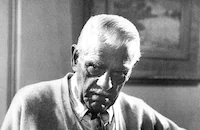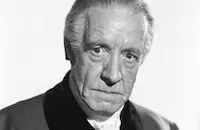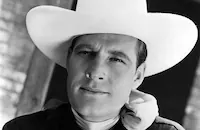The ever-popular character of Dr. Fu Manchu is the brainchild of Sax Rohmer (1883-1959). The English writer, whose real name is Arthur Sarsfield Ward, created thriller novels based on characters such as the female criminal mastermind Sumuru and the Parisian Detective Gaston Max. Rohmer's most successful series by far was the Fu Manchu novels, which spanned from 1913's The Mystery of Fu Manchu to Emperor Fu Manchu in 1959. The Fu Manchu character inspired a number of films over the years: a run of quickly-made British silent films starring Harry Agar Lyons, among them The Fiery Hand and The Cry of the Night Hawk (both 1923); the three Paramount films starring Warner Oland, including The Mysterious Dr. Fu Manchu (1929); the Hammer productions The Face of Fu Manchu (1965) and The Brides of Fu Manchu (1966), starring Christopher Lee; and The Fiendish Plot of Dr. Fu Manchu (1980), a comedy version starring Peter Sellers. There was also a television series, The Adventures of Fu Manchu (1956), starring Glen Gordon.
Rohmer's novel The Mask of Fu Manchu, on which this film is based, was serialized in Colliers from May to July of 1932. The hardcover version was published by Doubleday in October of that year. After earning worldwide fame for his roles in James Whale's Frankenstein (1931) and The Old Dark House (1932), Boris Karloff was selected for the lead and loaned out to MGM from Universal.
The Mask of Fu Manchu (1932) started production in early August, with Charles Vidor as director and Courtenay Terrett writing the screenplay adaptation. Within a couple weeks, they were fired; a new team of scriptwriters and a new director - Charles Brabin - were hired as replacements.
The production was rushed and chaotic, as Boris Karloff recalls: "I shall never forget, about a week before we started, I kept asking for a script - and I was met with roars of laughter at the idea that there would be a script. On the morning that we started shooting, I went into the makeup shop and worked there for about a couple of hours getting this extremely bad makeup on, as a matter of fact, for Fu Manchu. It was ridiculous. And, as I was in the makeup chair, a gentleman came in and handed me about four sheets of paper which was one enormous, long speech. That was to be the opening shot in the film and I was seeing it for the first time, then and there. It was written in the most impeccable English. Then, I said, 'This is absolute nonsense. I can't learn this in time to do it,' and he said, 'Well, it will be all right. Don't worry.' So I got my makeup on and, on my way to the stage from the makeup shop, I was intercepted by somebody else who took those pages away from me and gave me some others that were written in pidgin English!" Hollywood insiders called the project The Mess of Fu Manchu.
Myrna Loy, who plays the "sadistic nymphomaniac" Fah Lo See, had long been typecast as an exotic temptress. At her own insistence, this was her last of many roles as an Asian character. Nonetheless, she brings undeniable energy and conviction to the role, and her sensuality surely pushed the limits of the pre-Code era. In her autobiography Myrna Loy: Being and Becoming, the actress remarked upon seeing the film many years later: "...It astonished me how good Karloff and I were. Everyone else just tossed it off as something that didn't matter, while Boris and I brought some feeling and humor to those comic-book characters. Boris was a fine actor, a professional who never condescended to his often unworthy material." Her close friend Roddy McDowall liked to tease her about the role, calling her "Fu."
The production design for The Mask of Fu Manchu was quite elaborate and helped contribute to the picture's relatively high cost for the period - over $327,000. Director Charles Brabin recalls: "We took the mysteries of the Orient and blended them with ultra-modern science. ...For instance, the great Buddhas and other statues in the palace of Fu Manchu were copied from actual Oriental examples. Then we put in artificial lightning, Tesla coils, death-rays and other modern electrical wonders to show how the Oriental super-brain operated the strange laboratory in the chamber of the idols of his ancestors. Technicians copied almost everything in the British museum, from mummies to pterodactyls. The picture is literally a course in archaeology, Oriental religion, history and modern engineering rolled into one." The film's electrical equipment was created by Kenneth Strickfaden, who also designed the laboratory equipment for Universal's Frankenstein films. The famous mask in the film was based on the original designs by famed artist W. T. Benda for the novel's serialization in Collier magazine. The foremost mask maker of his day, Benda frequently worked on stage productions and even created special masks for fashion models. Last but not least came the complex makeup designed to transform Karloff into a Chinese character. The makeup, which required three hours preparation each day before shooting, involved filling in the area around Karloff's eyes, reshaping his nose, applying tooth caps and long fingernails, to say nothing of the wig, moustache and painted eyebrows.
Understandably, the character of Fu Manchu - Rohmer once described him as the "yellow peril incarnate" - has earned criticism over the years for its reliance on racist stereotypes. At the same time, the character in Rohmer's novels is extraordinarily intelligent and even displays noble traits; he and his nemesis Nayland Smith have a grudging respect for each other. This is a subtle point often lost in the film adaptations; The Mask of Fu Manchu in particular was attacked by the Chinese-American community when it was released. Boris Karloff dismissed such criticisms as "utterly ridiculous," since he felt the film was simply an escapist adventure not to be taken seriously. He continued to play Asian characters throughout his career, most notably the Chinese detective James Lee Wong in the Mr. Wong series for Monogram Pictures.
Director: Charles Brabin and Charles Vidor
Producer: Irving Thalberg
Screenplay: Irene Kuhn, Edgar Allan Woolf and John Willard, based on the novel The Mask of Fu Manchu by Sax Rohmer (1932)
Cinematography: Tony Gaudio
Editing: Ben Lewis
Art Direction: Cedric Gibbons
Costumes: Adrian
Principal cast: Boris Karloff (Dr. Fu Manchu), Lewis Stone (Nayland Smith), Karen Morley (Sheila Barton), Charles Starrett (Terrence Granville), Myrna Loy (Fah Lo See); Jean Hersholt (Von Berg), Lawrence Grant (Sir Lionel Barton), David Torrence (McLeod).
BW-69m. Closed captioning.
by James Steffen




























